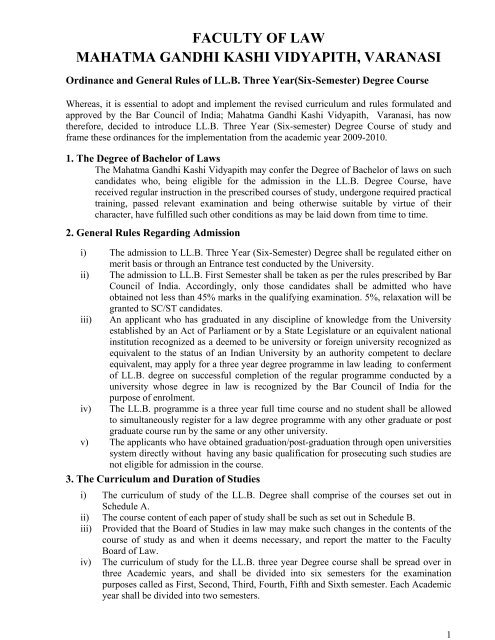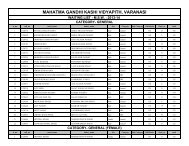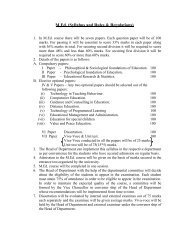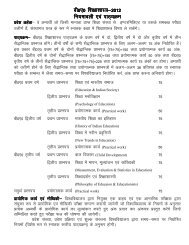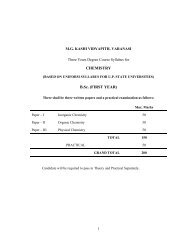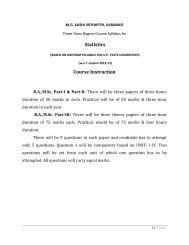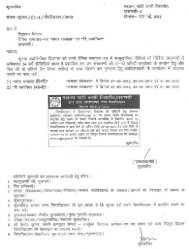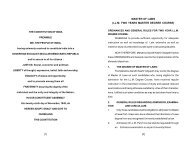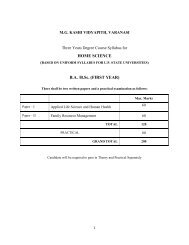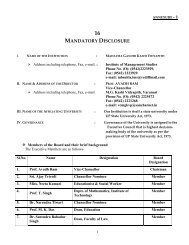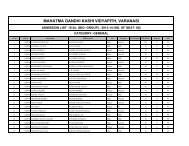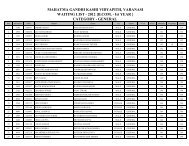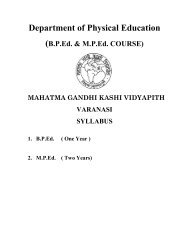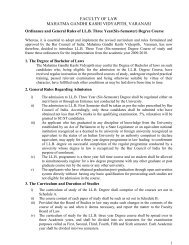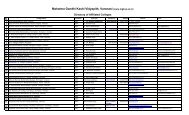faculty of law mahatma gandhi kashi vidyapith, varanasi
faculty of law mahatma gandhi kashi vidyapith, varanasi
faculty of law mahatma gandhi kashi vidyapith, varanasi
You also want an ePaper? Increase the reach of your titles
YUMPU automatically turns print PDFs into web optimized ePapers that Google loves.
1FACULTY OF LAWMAHATMA GANDHI KASHI VIDYAPITH, VARANASIOrdinance and General Rules <strong>of</strong> LL.B. Three Year(Six-Semester) Degree CourseWhereas, it is essential to adopt and implement the revised curriculum and rules formulated andapproved by the Bar Council <strong>of</strong> India; Mahatma Gandhi Kashi Vidyapith, Varanasi, has nowtherefore, decided to introduce LL.B. Three Year (Six-semester) Degree Course <strong>of</strong> study andframe these ordinances for the implementation from the academic year 2009-2010.1. The Degree <strong>of</strong> Bachelor <strong>of</strong> LawsThe Mahatma Gandhi Kashi Vidyapith may confer the Degree <strong>of</strong> Bachelor <strong>of</strong> <strong>law</strong>s on suchcandidates who, being eligible for the admission in the LL.B. Degree Course, havereceived regular instruction in the prescribed courses <strong>of</strong> study, undergone required practicaltraining, passed relevant examination and being otherwise suitable by virtue <strong>of</strong> theircharacter, have fulfilled such other conditions as may be laid down from time to time.2. General Rules Regarding Admissioni) The admission to LL.B. Three Year (Six-Semester) Degree shall be regulated either onmerit basis or through an Entrance test conducted by the University.ii) The admission to LL.B. First Semester shall be taken as per the rules prescribed by BarCouncil <strong>of</strong> India. Accordingly, only those candidates shall be admitted who haveobtained not less than 45% marks in the qualifying examination. 5%, relaxation will begranted to SC/ST candidates.iii) An applicant who has graduated in any discipline <strong>of</strong> knowledge from the Universityestablished by an Act <strong>of</strong> Parliament or by a State Legislature or an equivalent nationalinstitution recognized as a deemed to be university or foreign university recognized asequivalent to the status <strong>of</strong> an Indian University by an authority competent to declareequivalent, may apply for a three year degree programme in <strong>law</strong> leading to conferment<strong>of</strong> LL.B. degree on successful completion <strong>of</strong> the regular programme conducted by auniversity whose degree in <strong>law</strong> is recognized by the Bar Council <strong>of</strong> India for thepurpose <strong>of</strong> enrolment.iv) The LL.B. programme is a three year full time course and no student shall be allowedto simultaneously register for a <strong>law</strong> degree programme with any other graduate or postgraduate course run by the same or any other university.v) The applicants who have obtained graduation/post-graduation through open universitiessystem directly without having any basic qualification for prosecuting such studies arenot eligible for admission in the course.3. The Curriculum and Duration <strong>of</strong> Studiesi) The curriculum <strong>of</strong> study <strong>of</strong> the LL.B. Degree shall comprise <strong>of</strong> the courses set out inSchedule A.ii) The course content <strong>of</strong> each paper <strong>of</strong> study shall be such as set out in Schedule B.iii) Provided that the Board <strong>of</strong> Studies in <strong>law</strong> may make such changes in the contents <strong>of</strong> thecourse <strong>of</strong> study as and when it deems necessary, and report the matter to the FacultyBoard <strong>of</strong> Law.iv) The curriculum <strong>of</strong> study for the LL.B. three year Degree course shall be spread over inthree Academic years, and shall be divided into six semesters for the examinationpurposes called as First, Second, Third, Fourth, Fifth and Sixth semester. Each Academicyear shall be divided into two semesters.
2v) Each semester course shall be conducted in not less than 15 weeks with not less than 30class-hours per week including tutorials, moot court, seminar, workshops and speciallectures provided there shall be at least 24 lecture hours per week as prescribed by theBar Council <strong>of</strong> India.vi)The medium <strong>of</strong> instruction and examination shall be either English or Hindi. The studenthas to mention it in the examination form.4. Course <strong>of</strong> StudyA candidate for the three year LL.B. Degree course shall be required –i) To study five papers in each semester including clinical papers and must pass in allpapers with minimum <strong>of</strong> 36% marks in each paper and 45% marks in aggregate in eachsemester in order to qualify for LL,B. Degree.ii) To study Twenty compulsory theory papers, Six optional theory papers and one paper <strong>of</strong>General English and Legal Language carrying 100 marks for each paper through writtenexamination conducted by the University.iii) To study four compulsory clinical papers as prescribed in IV toVI semesters carrying 100marks for each paper through written examination conducted by the University andpractical work/viva-voce as prescribed by the Bar Council <strong>of</strong> India.iv) Each Institution <strong>of</strong> Law shall establish and run a legal Aid Clinic with the help <strong>of</strong> finalyear students and in co-operation with the Legal Aid Authorities.5. Examinationi) Any regular student who fails to secure 75% attendance in each paper will not beallowed to appear in examination. The aforesaid attendance requirement may be reducedupto 66% on recommendation <strong>of</strong> the Dean and approved by the Vice-chancellor on healthground or for any other reasonable cause.ii) There shall be an examination at the end <strong>of</strong> each semester <strong>of</strong> three years studyprogramme. Every student registered in any semester shall be eligible to appear in theconcerned examination <strong>of</strong> the respective semester, subject to the attendance requirementas prescribed by the Bar Council <strong>of</strong> India and the University. It shall be calculated on thesemester basis.iii) Candidate for the three year degree course (Bachelor <strong>of</strong> <strong>law</strong>s) shall be required to pass inall the prescribed courses within the span <strong>of</strong> six years from the academic session <strong>of</strong>his/her admission.iv) A candidate shall be examined in 20 compulsory and 06 optional theory papers and oneGeneral English and Legal Language paper from first to six semester carrying 100 marksfor each paper through written examination conducted by the University.v) The four compulsory clinical paper shall be examined as prescribed in contents <strong>of</strong> papers.vi) A Student must pass in all 30 Papers and in Legal and General English with a minimum<strong>of</strong> 36% marks in each and 45 in aggregate in each semester in order to qualify for theLL.B. Degree.vii) A student shall be promoted in third semester only after clearing eight papers <strong>of</strong> first andsecond semester. But he shall not be promoted to fifth semester without clearing all thepapers <strong>of</strong> first and second semester.viii) Similarly a student shall be admitted in fifth semester only after clearing nine papers <strong>of</strong>third and fourth semester.ix) There shall be an examination at the end <strong>of</strong> each semester.x) There shall be a viva-voce examination in practical/clinical papers.xi)xii)A student has to qualify both theory and practical examination.A student who obtaine 45% marks but less than 60% marks will be placed in 2 nd(Second)division and those who obtains 60% and above will be placed in 1 st (First)division.
36. Rules <strong>of</strong> Promotion, Back Papers and Improvementi) No student shall be promoted to next semester if he/she has been detained in theexamination for shortage <strong>of</strong> attendance.ii) A student <strong>of</strong> first and second semester shall be promoted in third semester if he/she hassecured 36% marks in each paper and 45%marks in aggregate in each semester.iii) Similarly a student <strong>of</strong> third and Fourth semester shall be promoted in fifth semester ifhe/she has secured 36%marks in each paper and 45% marks in aggregate in eachsemester.iv)A student enrolled in first semester shall be promoted in second semester and similarlystudent enrolled in third semester shall be promoted in fourth semester.v) A student who has secured pass mark 36%in each paper, but failed to secure aggregate <strong>of</strong>45%will be allowed to appear in back paper examination held in the next year asaccording to para -vi, vii & viii.vi)A student will be allowed to appear in back paper examination only one papers in eachsemester.vii) A student who has secured more than 36%marks in each paper but not secured 45%aggregate, he shall be eligible to appear in one back paper if he / she obtained 42% marksin aggregate in each semeater.viii)ix)A student who has not appeared or failed either in one paper in each semester and has got42% marks as an aggregate shall be eligible to appear in back paper examination.A student <strong>of</strong> IV th semester shall be promoted in V th semester only when he is declaredpassed in I st & II nd semester.x) Improvement examination <strong>of</strong> LL.B. (I to Vl semester will be held as per Universityrules)7. Re- admission Rulesi) There shall be no re- admission in the LL.B. First ,Third and Fifth semester.ii) A student who has failed in examination or failed to appear in the examination andwho is otherwise eligible to appear in the examination as an ex-student shall not beadmitted as a regular student.8. Miscellaneous Provisionsi) These ordinances contained herein shall be deemed to have come into effect fromthe academic session 2011-2012 to the extent <strong>of</strong> its applicability.ii) Any provision contained in earlier ordinances in this regard repugnant to thepresent ordinances shall stand deleted.
4SCHEDULE – A(CURRICULUM)LL.B. THREE YEAR (SIX- SEMESTER) DEGREE COURSE OF STUDYLL.B. First SemesterPaper – I : Constitutional Law – IPaper - II : Law <strong>of</strong> Contract – IPaper - III : Law <strong>of</strong> Tort including MV Accident and Consumer Protection LawsPaper - IV : Family Law – IPaper - V : Public International LawLL.B. Second SemesterPaper – I : Constitutional Law – IIPaper - II : Law <strong>of</strong> Contract – IIPaper - III : Family Law – IIPaper - IV : Law <strong>of</strong> Crime – I (Indian Penal Code)Paper - V : Administrative LawLL.B. Third SemesterPaper – I : JurisprudencePaper - II : Interpretation <strong>of</strong> Statutes and Principles <strong>of</strong> LegislationPaper - III : Company LawPaper - IV : Labour Law - IPaper - V : Property LawPaper – VI : General English and Legal LanguageLL.B. Fourth SemesterPaper – I : Labour Law -IIPaper - II : Civil Procedure Code and Limitation Act.Paper - III : Law <strong>of</strong> EvidencePaper - IV : Law <strong>of</strong> Crime – II (Criminal Procedure Code)Paper - V : Pr<strong>of</strong>essional Ethics and Pr<strong>of</strong>essional Accounting System (Clinical)LL.B. Fifth SemesterPaper – I : Human Rights Law and PracticePaper - II : Environmental LawPaper - III : Land Law including Tenure & Tenancy SystemPaper - IV : Banking LawPaper - V : Pleading Drafting and Conveyancing (Clinical)LL.B. Sixth SemesterPaper – I : Principles <strong>of</strong> Taxation LawPaper - II : Penology & VictimologyPaper - III : CopyrightPaper - IV : Alternative Dispute Resolution (Clinical)Paper - V : Moot Court Exercise and Internship (Clinical)
5SCHEDLE – B(DETAIL COURSE CONTENT)LL.B. First SemesterPAPER – ICONSTITUTIONAL LAWMarks : 100Unit I : Constitution• Definition and Classification• Sources <strong>of</strong> Constitution• Constitutional Conventions• Salient features <strong>of</strong> Indian Constitution• Rule <strong>of</strong> Law• Separation <strong>of</strong> PowersUnit – II : Distribution <strong>of</strong> Powers between Union and States• Legislative Powers, Administrative Powers, Financial Powers• Doctrine <strong>of</strong> Territorial Nexus, Doctrine <strong>of</strong> Harmonious Construction, Doctrine <strong>of</strong> Pith andSubstance• Doctrine <strong>of</strong> RepugnancyUnit – III : Constitutional Organs(i) Parliament (ii) Parliamentary Sovereignty (iii) Parliamentary Privileges (iv) Anti-DefectionLaw (v) Executive Power (vi) Collective Responsibility <strong>of</strong> Cabinet (vii) Judiciary : Jurisdiction <strong>of</strong>Supreme court and High Courts (viii) Independence <strong>of</strong> Judiciary (ix) Public Interest Litigation (x)Power <strong>of</strong> Judicial Review (xi) Doctrine <strong>of</strong> Political QuestionUnit – IV :Emergency Provisions, Amendment <strong>of</strong> Constitution, Doctrine <strong>of</strong> Basic Structure, Contractual andTortious Liability <strong>of</strong> State, Right to Property and freedom <strong>of</strong> Trade & Commerce.Books1. D.D. Basu, Shorter Constitution <strong>of</strong> India, Wadhwa, Nagpur2. H.M. Seervai, Constitution <strong>of</strong> India, Tripathi Bombay3. V.N. Shukla, Constitution <strong>of</strong> India, Eastern Book Co. Lucknow4. M.P. Jain, Constitution <strong>of</strong> India, Wadhwa Nagpur
6LL.B. First SemesterPAPER – IICONTRACT – IMarks : 100Unit I : Formation <strong>of</strong> ContractMeaning and Nature <strong>of</strong> contractProposal and Acceptance, Communication and Revocation, Consideration, Capacity to enter into aContract, Minor’s Position, Unsoundness <strong>of</strong> Mind, Privity <strong>of</strong> Contract.Unit II : Validity and Discharge <strong>of</strong> ContractConsent and Free ConsentCoercion, Undue Influence, Misrepresentation, FraudUn<strong>law</strong>ful Consideration and ObjectContingent contract, Void, Voidable, Valid, Illegal, Un<strong>law</strong>ful and Uncertain Agreement/contractDischarge <strong>of</strong> ContractUnit III : Performance <strong>of</strong> contractPerformance : Time and PlaceAgreement, Impossibility <strong>of</strong> Performance and FrustrationBreach : Anticipatory and PresentUnit IV : Remedies and Quasi ContractRemedies, Damages, Kinds, Remoteness etc.Quantum MeruitQuasi-Contract (Section 68 - 72)Specific Relief Act : Injunction, Specific PerformanceBooks1 . Anson - Law <strong>of</strong> Contract (1998), Universal, Delhi2. Pollock and Mulla – India Contract3. Avtar Singh – Law <strong>of</strong> Contract, Eastern Book Co. (Lucknow)
7LL.B. First SemesterPAPER – IIILAW OF TORT INCLUDING MV ACCIDENT AND CONSUMER PROTECTONLAWSMarks : 100Unit I :Introduction and Principles in Tort• Nature, Definition and Development <strong>of</strong> Tort• Tort Distinguished from Contract, Crime and Breach <strong>of</strong> Trust. Wrongful Act –Damnum Sine Injuria and Injuria Sine Damnum• Joint and Separate Tort fearers• Doctrine <strong>of</strong> Remoteness <strong>of</strong> Damages• Vicarious Liability.Unit II :• State Liability for Torts : Doctrine <strong>of</strong> Sovereign Immunity• Liability under the M.V. Act, 1988• Torts against Person : Assault, Battery and False Imprisonment• Torts against property – Trespass, Conversion, Trespass to Land and Malicious Prosecution.Unit III :• Negligence, Res Ipsa Loquitor, Contributory Negligence• Strict and Absolute Liability,• Nervous Shock• Nuisance• DefamationUnit IV :• Consumer Protection Act : Consumerism in India (Historical Background),Consumers : the concept, definition, scope and object <strong>of</strong> C.P. Act, Rights <strong>of</strong>Consumers.Acts• Consumer Protection Act, 1986Books1 . R.K. Bangia – Law <strong>of</strong> Torts2. Ratan Lal & Dhiraj Lal – The Law <strong>of</strong> Torts (1997), Universal Delhi
8LL.B. First SemesterPAPER – IVFAMILY LAW - IMarks : 100HINDU LAWUnit I :• Nature, Who is Hindu & Sources <strong>of</strong> Hindu Law• Hindu Marriage Act, 1955 : (Sec.5 - 23)Unit II• Maintenance Under Hindu Marriage Act (Sec.24 & 25)• Maintenance Under Hindu Adoption and Maintenance Act, 1956 (Sec.18, 19 & 20)Adoption : Essentials & Effect (Sec.6 to 12 <strong>of</strong> HA&MA, 1956)• Kinds and Powers <strong>of</strong> guardian under Hindu Minority & Guardianship Act, 1956MUSLIM LAWUnit III• Nature & Sources <strong>of</strong> Muslim Law, Who is Muslim ?• Muslim Marriage : Essentials, Option <strong>of</strong> puberty, Kinds <strong>of</strong> Marriage under Sunni Law &Shia LawUnit III : Divorce• Classification <strong>of</strong> Divorce• Maintenance <strong>of</strong> Wife Under Muslim personal <strong>law</strong>, Cr.P.C. and Muslim Women(Protection <strong>of</strong> Right <strong>of</strong> Divorce) Act, 1986• Parentage and Legitimacy• Kinds and Powers <strong>of</strong> guardianActs1. Hindu Marriage Act, 19552. Hindu Adoption and Maintenance Act,19563. Hindu Minority and Guardianship Act, 19564. Muslim Women (Protection <strong>of</strong> Right on Divorce) Act, 1986Books1. J.D.M. Derrett – Hindu Law2. Mulla – Hindu Law, (18 th Ed. 2002) Butterworth Publication3. Paras Diwan, Hindu Law, Allahabad Law Agency
9LL.B. First SemesterPAPER – VPUBLIC INTERNATIONAL LAWMarks : 100Unit I :• Nature, Definition, Origin and Basis <strong>of</strong> International Law• Sources <strong>of</strong> International Law• Subjects <strong>of</strong> International Law• Relationship between International Law and Municipal LawUnit II :• Recognition : Definition, Theories <strong>of</strong> Recognition, Kinds <strong>of</strong> Recognition, Legal effect <strong>of</strong>Recognition, Withdrawl <strong>of</strong> Recognition.• Extradition : Definition, Purpose <strong>of</strong> Extradition, Legal Duty, Extradition <strong>of</strong> Political Offenders,Doctrine <strong>of</strong> Double Criminality, Rule <strong>of</strong> Specialty.• Asylum : Meaning, Right <strong>of</strong> Asylum, Types <strong>of</strong> Asylum• Intervention : Definition and Its Prohibition, Ground <strong>of</strong> Intervention.Unit III :• State Territory : Concept, Modes <strong>of</strong> Acquisition, International Rivers.• State Jurisdiction - Territorial Jurisdiction and Its Limitation• State Succession : Definition and Kinds <strong>of</strong> Succession Consequences <strong>of</strong> State Succession.• State Responsibility : Kinds <strong>of</strong> State Responsibility, Consequence <strong>of</strong> State Responsibility.Unit IV :• U.N. : Origin, Object, Principles and Membership• Main organs <strong>of</strong> U.N. : General Assembly, Security Council Economic and Social Council,Trusteeship Council and Secretariat, International Court <strong>of</strong> Justice.• Settlement <strong>of</strong> International DisputeBook1. Starke : Introduction to International Law2. S.K. Kapoor : Public International Law3. H.O. Agrawal : International Law and Human Rights
10LL.B. Second SemesterPAPER – ICONSTITUTIONAL LAW - IIMarks : 100Unit I : Fundamental Rights• Definition <strong>of</strong> State for enforcement <strong>of</strong> fundamental rights, Justifiability <strong>of</strong> fundamentalrights, Doctrine <strong>of</strong> eclipse, severability, waiver, distinction between pre-constitutional <strong>law</strong>and post constitutional <strong>law</strong>• Right to Equality : Doctrine <strong>of</strong> Reasonable classification and the principle <strong>of</strong> absence <strong>of</strong>arbitrariness.• Fundamental Freedom : Freedom <strong>of</strong> Speech and Expression, Freedom <strong>of</strong> Association,Freedom <strong>of</strong> Movement, Freedom <strong>of</strong> Reside and Settle, Freedom <strong>of</strong> Trade, Business andPr<strong>of</strong>ession-expansion by judicial interpretation-reasonable restrictions.Unit II : Fundamental Rights• Right to life and personal liberty-scope and content (expensive interpretation)• Preventive detention under the Constitution-Policy and safeguards-Judicial review• Right against exploitation-forced labour and child employment• Freedom <strong>of</strong> religion• Education and cultural rightsUnit III : Rights to Constitutional Remedies• Right to Constitutional Remedies-Judicial Review• Writs : Habeas Corpus, Mandamus, Certiorari, Prohibition and Quo-warranto-Art.32 and 226Unit IV : Directive Principles, Fundamental Duties, Social Justice and Right toInformation• Directive Principles <strong>of</strong> State Policy –Nature and Justifiability <strong>of</strong> the Directive Principles-Interrelationship between Fundamental Rights and Directive Principles, Fundamental Duties• Social Justice under the Indian Constitution, Compensatory discrimination for backwardclasses Mandal Commission’s case and other cases-Protective discrimination doctrine• Right to Information Act, Central and State Commission, Public Authorities, Right toInformation and Power <strong>of</strong> Judicial ReviewBooks : Same as Semester I
11LL.B. Second SemesterPAPER – IICONTRACT - IIMarks : 100Unit I :Indemnity and Guarantee (Sec 124 - 147)Indemnity & Guarantee – The Concept, Definition, Methods, Commencement <strong>of</strong> Liability <strong>of</strong> theIndemnifier, Right/Duties <strong>of</strong> Indemnifier, Indemnified and Surety, Discharge <strong>of</strong> Sureties LiabilityKinds <strong>of</strong> GuaranteeUnit II : Bailment and Pledge (Sec. 148–171 and Sec 172-182)• Meaning and Distinction• Rights and Duties <strong>of</strong> Bailer/Bailee, Pawnor /Pawnee• Lien• Termination <strong>of</strong> Bailment• Commercial utility <strong>of</strong> pledge transactionAgency (Sec.182 to 238)• Definition <strong>of</strong> Agent & Principal• Essentials <strong>of</strong> relationship <strong>of</strong> Agency• Creation <strong>of</strong> Agency• Relation <strong>of</strong> Principal and Agent, Sub-agent and Substituted agent• Termination <strong>of</strong> AgencyUnit III :PartnershipNature & Definition <strong>of</strong> Partnership, Distinction from Company and Joint Family Business,Relationship between partners, Incoming and outgoing partners (Sec. 30 to 38), Dissolution <strong>of</strong> Firm(Sec. 39 to 55), Registration <strong>of</strong> Firm (Sec. 56 to 71) Implied Authority, Relationship with third party.Liability <strong>of</strong> partners holding out, Admission <strong>of</strong> New Partner, Modes Retirement <strong>of</strong> PartnersUnit IV : Sales <strong>of</strong> GoodsDefinition, Condition and Preference, Formation <strong>of</strong> Contract (Sec. 4 to 17), Effect <strong>of</strong> contract (See18 to 31), Right <strong>of</strong> Parties and Remedies, Performance <strong>of</strong> Contract (Sec 31 to 44), Rights <strong>of</strong> UnpaidSeller (Sec. 45 to 54), Suits for Breach <strong>of</strong> Contract (Sec 55 to 61).Acts :1. Indian Contract Act, 18722. Indian Partnership Act, 19323. The Sale <strong>of</strong> Goods Act, 1930Books1. Avtar Singh : Partnership & Sales <strong>of</strong> Goods Act, Eastern Book Co.2. Mulla, Partnership & Sales <strong>of</strong> Goods Act, Tripathi3. Dr. R.K.Bangia, Partnership Act.
12LL.B. Second SemesterPAPER – IIIFAMILY LAW - IIMarks : 100HINDU LAWUnit I : Joint Hindu FamilyOrigin, Nature <strong>of</strong> Join Family and Coparcenary, Characteristic features <strong>of</strong> Coparcenary, Distinctionbetween Coparcenary and Joint Family, Classification <strong>of</strong> Property : Joint Family Property andSeparate Property, Karta : Position, Powers and Liabilities, DebtsUnit II• Partition : Definition, Persons entitled to demand Partition, reopening and Reunion• Hindu Succession Act, 1956 : Features, Devolution <strong>of</strong> Interest in Coparcenaries Property (Sec.6), List<strong>of</strong> heirs in class-I & II <strong>of</strong> the Schedule, Hindu Women’s Right to PropertyMUSLIM LAWUnit III• Hiba : Definition, Essentials, KInds and Formalities for a Valid Hiba Revocation <strong>of</strong> Hiba.• Will : Definition, Essentials and Kinds <strong>of</strong> a Valid Will, Abatement <strong>of</strong> Legacies, Revocation <strong>of</strong> WillUnit IV• Pre-emption : Definition, Classification & Formalities• Inheritance under Sunni Law, Doctrine <strong>of</strong> Aul and RaddAct1. Hindu Succession Act, 1956Books• Same as Semester I
13LL.B. Second SemesterPAPER – IVLAW OF CRIME – I (INDIAN PENAL CODE)Marks : 100Unit I : IntroductionDefinition and elements <strong>of</strong> Crime, Stages <strong>of</strong> CrimePrinciple <strong>of</strong> Joint Liability : Common Intention and Common object, General exception (Sec. 76-106) –Mistake, Judicial and Executive acts, Accident, Necessity and Compulsion, act <strong>of</strong> minor,Insanity, Intoxication, Consent, Private Defense.Unit II :Abetment and Criminal Conspiracy (Sec 107 to 114) and Sec120, Offences affecting the Humanbody – Culpable Homicide, Murder, Death caused by Negligent act, Dowry Death, Hurt andGrievous HurtUnit III : Wrongful Restraint and Wrongful Confinement, Offences <strong>of</strong> kidnapping and Abduction.Offences against property; Theft, Extortion, Robbery and Dacoity.Unit IV :• Cheating, Criminal Trespass, Forgery, Criminal misappropriation, Criminal breach <strong>of</strong> trust.• Offences against women – <strong>of</strong>fences relating to Marriage, Cruelty by husband or relatives <strong>of</strong>husband• Defamation• Criminal Intimidation, Sedition• Preparation and AttemptActs :• The Indian Penal Code, 1860Books1. Penal Law <strong>of</strong> India – H.S. Gaur (In IV Volumes)2. Nigam R.C. – General Principles <strong>of</strong> criminal Law3. Jerome Hall, Principles <strong>of</strong> Criminal Law4. S.N. Mishra : Indian Penal Code.
14LL.B. Second SemesterPAPER – VADMINISTRATIVE LAWMarks : 100Unit I : IntroductionEvolution and Scope <strong>of</strong> Administrative Law :Nature, Scope and Development <strong>of</strong> Administrative LawRule <strong>of</strong> Law and Administrative Law, Separation <strong>of</strong> Powers and its Relevance, Relationship betweenConstitutional Law and Administrative Law.Unit II :• Delegated Legislation – Necessity and Constitutionality, Control : Legislative, Judicial andProcedural• Principles <strong>of</strong> Natural Justice• Administrative Tribunal and Administrative DiscretionUnit III :• Liability <strong>of</strong> Wrong – Tortious and Contractual• Statutory immunity, Governmental Privilege in Legal proceedings, Estoppel and Waiver.• Public Interest LitigationUnit IV :• Judicial Control <strong>of</strong> Administrative LawWrits, Injunction, Declaratory Suit, Accountability, Lokpal and Lokyaukta, Right toInformation ActBooks1. M.P.Jain : Principles <strong>of</strong> Administrative Law, Universal Delhi.2. S.P Sathe, Administrative Law, Butterwarth, Delhi3. C.K.Thakkar, Administrative Law, Estern Book Co.
15LL.B. Third SemesterPAPER – IJURISPRUDENCEMarks : 100Unit I : Introduction• Meaning, Scope and Importance <strong>of</strong> Jurisprudence.• Relation between Jurisprudence and other Sciences, Nature and Kinds <strong>of</strong> Law and Theories<strong>of</strong> Justice.• Sources <strong>of</strong> Law : Custom, Legislation, PrecedentUnit II : Schools <strong>of</strong> Jurisprudencea) Natural Law with Indian Perspectiveb) Analytical Positivism, Pure Theory, Legal Realismc) Historical Jurisprudenced) Sociological Jurisprudence with Indian PerspectiveUnit III : Law and Legislation• Law and Morality• Law and Religion• Law and Social Change• Principles <strong>of</strong> Liability : Liability and Negligence, Absolute, Liability, Immunity.Unit IV : Concept <strong>of</strong> Law• Rights and Duties• Personality• Possession, Ownership and PropertyBooks :1. Bondenheimer : Jurisprudence – The Philosophy and Method <strong>of</strong> Law (1996) Universal, Delhi2. R.W.M. Dias : Jurisprudence (1994) Indian Reprint – Aditya Books, Delhi3. Fitzgerald P.J. Salmond on Jurisprudence (1994), Tripathi, Bombay4. Dhyani S.N. : Jurisprudence – A Study <strong>of</strong> Indian Legal Theory (1985)
16LL.B. Third SemesterPAPER – IIINTERPRETATION OF STATUTES AND PRINCIPLES OF LEGISLATIONMarks : 100Unit I : InterpretationMeaning, Object, General Principles and their Importance, Difference between Interpretation andConstructionStatutes : Meaning and its ClassificationLiteral Rule, Golden RuleUnit II :Mischief Rule Beneficial ConstructionStrict Construction – In reference with Penal and Taxing LawsMaxims <strong>of</strong> Interpretation and their ImportanceUnit III :Interpretation <strong>of</strong> Constitutional LawInternal and External Aids to InterpretationCommencement, repeal and Revival <strong>of</strong> LegislationUnit IV : Principles <strong>of</strong> LegislationDoctrine <strong>of</strong> UtilityDoctrine <strong>of</strong> Pleasure and PainDoctrine <strong>of</strong> Sympathy and AntipathyPublic Opinion and LegislationBooks1. Maxwell on Interpretation2. Vepa P. Sarathi : Interpretation <strong>of</strong> Statutes3. Bawa & Roy, Interpretation <strong>of</strong> Statutes4. G.P. Singh, Principles <strong>of</strong> Statutory Interpretation, 1999 Wadhwa5. Bentham : Theory <strong>of</strong> Legislation, N.M.Tripathi Pvt. Ltd.
17LL.B. Third SemesterPAPER – IIICOMPANY LAWMarks : 100Unit I : Formation, Registration and Incorporation <strong>of</strong> CompanyDefinition and Kinds <strong>of</strong> CompanyNature <strong>of</strong> Company : Theory <strong>of</strong> Corporate PersonalityIncorporation <strong>of</strong> Company : Memorandum <strong>of</strong> Association and Articles <strong>of</strong> Association, Doctrine <strong>of</strong>Ultra-vires.Unit II : Capital Formation and RegulationProspectus : Issue, contents, Kinds, liabilities for misstatement, statement in lieu <strong>of</strong> ProspectusPromoters : Position, duties and liabilities.Share and General Principles <strong>of</strong> allotmentTransfer <strong>of</strong> Shares, Restriction on transfer, Relationship between transfer and transferee.Share Capital, Reduction <strong>of</strong> Share Capital, Conversion <strong>of</strong> Loan as, debentures into capitalDuties <strong>of</strong> Court to protect interest <strong>of</strong> creditors and share holders.Unit III : Administration and ManagementDividend – Payments – Capitalization – Pr<strong>of</strong>it, Audit to AccountDirectors Appointment – Kinds, Powers and DutiesRole <strong>of</strong> Managing Director and other Managerial PersonalOppression and MismanagementUnit IV : Winding up <strong>of</strong> Companies• Kinds, Consequences and reason <strong>of</strong> winding up• Role <strong>of</strong> the Court• Liabilities <strong>of</strong> Past members• Payment <strong>of</strong> Liabilities• Reconstruction and Amalgamation• Legal Liabilities <strong>of</strong> Company – Civil & Criminal, Remedies against themBook1. Avtar Singh, Company Law
18LL.B. Third SemesterPAPER – IVLABOUR LAW - I(LAW RELATING TO LABOUR MANAGEMENT RELATIONS IN INDIA)Marks : 100Unit I :Industrial Relation, Labour Problem and Labour Policy in IndiaTrade Union Act, 1926 (Labour Management Relation); History and Development <strong>of</strong> Trade UnionMovement, Registration <strong>of</strong> Trade Union, Rights and Liabilities <strong>of</strong> Registered Trade Union, Penaltiesand procedure, Collective Bargaining – Process, Merit and DemeritUnit II : Industrial Dispute Act, 1947Scope <strong>of</strong> Industry, Workmen, Employers, Industrial Disputes, Authorities under the IndustrialDispute Act, 1947; Procedure, Power and Duties <strong>of</strong> Authorities, Reference <strong>of</strong> Disputes to Boards.Courts or TribunalsUnit III :Strike, Lock Out, Lay Off, Retrenchment and ClosureUnfair Labour Practices, Penalties, Offences (Standing Order) Act, 1946by Industrial EmploymentUnit IV :Philosophy <strong>of</strong> Labour Welfare, Historical Development <strong>of</strong> Labour Welfare, The Factories Act, 1948:Interpretation-competent person, Hazardous process, manufacturing process, Worker, Factory,Occupier, Health, Safety and Welfare, Working House <strong>of</strong> Adults, Employment <strong>of</strong> young persons,Inspectors - Appointment and Powers.Acts1. Trade Union Act, 19262. Industrial Dispute Act, 19473. Factories Act, 1948Books1. John Bowers & Simon Honey Ball, Text Book on Labour Law2. K.M. Pillai, Labour and Industrial Laws, 19993. V.G. Goswami, Labour and Industrial Laws, 19994. D.D. Seth, Commentaries on Industrial Disputes Act, 1998
19LL.B. Third SemesterPAPER – VPROPERTY LAWMarks : 100Unit I : Concept <strong>of</strong> Property and General Principles Relating to Transfer <strong>of</strong> PropertyConcept <strong>of</strong> Property : Distinction between movable and immovable propertyDefinition clause : Immovable property, Attestation, Notice, Actionable claimDefinition <strong>of</strong> transfer <strong>of</strong> property (Sec.5)Transfer and non-transfer <strong>of</strong> property (Sec. 10- 12)Vested and Contingent interest (Sec. 19 & 21)Rule <strong>of</strong> Election (Sec.35)Unit II : General Principles Governing Transfer <strong>of</strong> Immovable PropertyTranfer by ostensible ownerRule <strong>of</strong> feeding the grant by estoppelsRule <strong>of</strong> Lis-pendenceFraudulent transferRule <strong>of</strong> part - performanceConditional transferUnit III : Specific TransfersSale and giftMortgage and chargeLease and LicenseUnit IV : Easement ActObject and main provisions <strong>of</strong> the Easement ActActs1. The Transfer <strong>of</strong> Property Act, 18822. The Indian Easement Act, 1882Books1. Mulla, Transfer <strong>of</strong> Property Act, Universal Delhi2. Subba Rao, Transfer <strong>of</strong> Property Act, Subbiah Chetty, Madras3. T.P.Tripathi, Transfer <strong>of</strong> Property Act
20LL.B. Third SemesterPAPER – VILEGAL LANGUAGE(INCLUDING LEGAL AND GENERAL ENGLISH)Marks : 100Grammar and Usage1. Simple Sentencesi) Tense and Compositionii) Basic Transformations(a) Active to Passive (b) Simple to Negative (c) Affirmative to Interrogative2. Complex and Compound Sentence3. Part <strong>of</strong> Speech4. Vocabulary – Terms <strong>of</strong> Common Use5. Composition Skills - Paragraph Writing6. Translation – Hindi to English7. Letter and Application writing8. Essay (a) Essay in Hindi on Legal Topics(b)Essay in English on Legal Topics (for example) : Fundamental Rights underthe Indian Constitution, Secularism, Social Justice, Consumer Protection,Women’s Right, Public Interest Litigation, Lok Adalat etc.9. Legal words – Terms and Phrases10. One word substitution11. Abbreviation12. Précis WritingBooks :1. Pr<strong>of</strong>. Anniruddha Prasad, Legal Language2. Dr. S.K. Gupta, Legal Language and General English
21LL.B. Fourth SemesterPAPER – ILABOUR LAW – II(SOCIAL SECURITY AND WAGE LEGISLATION)Marks : 100Unit I : Workmen’s Compensation Act, 1923 (Sec. 1-10, 12, 14, 14A, 17 & 20)• Conceptual frame work <strong>of</strong> Social Security- Evolution and concept <strong>of</strong> Social Security,Scheme <strong>of</strong> Social Security, Workmen’s Compensation Act, 1923 : Definitions, Aims &Object, Liability <strong>of</strong> Employer.• Notional Extension & Defences, Determination <strong>of</strong> Amount <strong>of</strong> Compensation, Compensationwhen due, Penalty for default, Contracting Out (Sec.17), Appointment & Powers <strong>of</strong>Commissioner (Sec. 19-31)Unit II : Maternity Benefit Act, 1961 (Sec. 3-18)• Aims & Object, Definitions, Restriction on employment, Right to Maternity Benefit, MedicalBenefit.• Bonus, Leave Dismissal during Pregnancy (Sec. 10-16), forfeiture <strong>of</strong> Maternity benefit,Leave for Miscarriage, Penalty for contravention <strong>of</strong> Act by Employer, Cognizance <strong>of</strong><strong>of</strong>fences.• The Payment <strong>of</strong> Gratuity Act, 1972 : Aims and Objects <strong>of</strong> Act, Definition, ControllingAuthority, Payment <strong>of</strong> Gratuity, Recovery <strong>of</strong> Gratuity, Recovery <strong>of</strong> Gratuity, Determination<strong>of</strong> the amount <strong>of</strong> GratuityUnit III : Minimum Wages Act, 1948• Theories and Concept <strong>of</strong> Wages, Aims & Objects <strong>of</strong> Act, Definition , Fixation & Revision <strong>of</strong>rates <strong>of</strong> Wages, Working Hours and Determination <strong>of</strong> Wages and claim etc. Authority –Appointment & Powers <strong>of</strong> the Authority.• The Equal Remuneration Act, 1976, Payment <strong>of</strong> Remuneration at equal rates to Men andWomen workers and other matters.Unit IV : Payment <strong>of</strong> Wages Act, 1936• Aims & Object, Responsibility <strong>of</strong> Payment <strong>of</strong> Wages, Time <strong>of</strong> Payment <strong>of</strong> Wages & Fixation<strong>of</strong> Wage Period, Authorized Deductions (Sec.7 to 13), Appointment & Powers <strong>of</strong> Inspectorsand Authority for Adjudication <strong>of</strong> Claims (Sec.15-18), Penalty for <strong>of</strong>fences under the Act.• The Payment <strong>of</strong> Bonus Act : Scope and Application, Definition, Computation <strong>of</strong> Gross pr<strong>of</strong>itand available surplus, Eligibility for Bonus, Disqualification for Bonus, Minimum andMaximum Bonus.Acts1. Workmen’s Compensation Act, 19232. Maternity Benefit Act, 19613. Payment <strong>of</strong> Wages Act, 19364. Minimum Wages Act, 1948Books1. K.D.Srivastava, Commentaries on Minimum Wages Act, 1995, Eastern Book Co.2. K.D. Srivastava, Commentaries on Payment <strong>of</strong> Wages Act, 1998, Eastern Book Co.
22LL.B. Fourth SemesterPAPER – IICODE OF CIVIL PROCEDURE & LIMITATION ACTMarks : 100Unit I : IntroductionDefinition : Decree, Judgment, Order, Foreign Court, Foreign Judgment , Mesne Pr<strong>of</strong>it, Affidavit,Plaint, Written statement , Legal Representative, Distinction between Decree & Judgment andbetween Decree and Order.Jurisdiction : Kinds, Hierarchy <strong>of</strong> Courts, Suit <strong>of</strong> a Civil nature, Concepts <strong>of</strong> Res-Subjudice andResjudicata, Place <strong>of</strong> Suing, Institution <strong>of</strong> Suit, Parties to the suit, Joinder, Misjoinder or non-joinder<strong>of</strong> parties, Representative suit, Framing <strong>of</strong> suit, Cause <strong>of</strong> Action.Unit II : Appearance, Examination & TrialAppearance, Ex-parte Procedure, Summary & Attendance <strong>of</strong> witness, Trial, Adjournments, Interimorders, Commission Arrest and Attachment before judgment, Injunction and Appointment <strong>of</strong>Receiver, Interest and Costs.Execution : Concept, General Principles, Power <strong>of</strong> execution <strong>of</strong> decrees, Procedure for execution,enforcement, Arrest and detention, Attachment, Sale, Delivery <strong>of</strong> Property, Stay <strong>of</strong> exectution.Unit III : Suits in particular CaseBy or against government, By or against firm, Suit in forma pauperis, Interpleader suit Appeals,Review, Reference & RevisionUnit IV : MiscellaneousTransfer <strong>of</strong> cases, Restitution, Caveat, Inherent powers <strong>of</strong> Courts.Law <strong>of</strong> Limitation : Meaning, Nature & Scope <strong>of</strong> Law <strong>of</strong> Limitation, Bar <strong>of</strong> Limitation and itsefficacy, sufficient cause its meaning and applicability, Legal Disability : Meaning, Scope & Effect,Continuous running <strong>of</strong> time, General Principles, Meaning, Scope & its exception, Law Relating toRegistration <strong>of</strong> documents.Act• The Civil Procedure Code, 1908• The Limitation Act, 1963Books1. C.K.Thakkar, Code <strong>of</strong> Civil Procedure 2000, Universal Delhi2. C.K. Takwani, Code <strong>of</strong> Civil Procedure
23LL.B. Fourth SemesterPAPER – IIILAW OF EVIDENCEMarks : 100Unit I : Introduction and RelevancyDefinition : Facts in issue, relevant fact, evidence, oral and documentary evidence, proved,disproved , not proved (Sec. 3)Relevancy and admissibilityDoctrine <strong>of</strong> res gestate (Sec. 6,7,8,9)Conspiracy (Sec. 10)Facts concerning mental or bodily stateFacts otherwise relevantAdmission (Sec17-23+31), Confession (Sec. 24-30) Dying declaration, Expert opinion, JudicialNoticeUnit II : Method <strong>of</strong> Proving factsPresumptions (Sec. 4,41,79,90,105,107,108,112,113-a,114 and 114-A)Rules relating to burden <strong>of</strong> pro<strong>of</strong>, Estoppel (Sec.101-117) , Privileged Communication (Sec 122-129)Unit III : Presumption regarding discharge <strong>of</strong> Burden <strong>of</strong> Pro<strong>of</strong>Evidence by accomplice [(Sec. 133 and 114 illustration(b)]Dowry death, legitimacy <strong>of</strong> childUnit IV :Competent witnessesHostile witnessesExamination <strong>of</strong> witnesses : Chief examination, Cross examination and Re-examination.Number <strong>of</strong> witnesses, order <strong>of</strong> examination, leading questionAct :• Indian Evidence Act,1872Books :1. Ratan Lal & Dheeraj Lal, Law <strong>of</strong> Evidence2. Avatar Singh, Law <strong>of</strong> Evidence
24LL.B. Fourth SemesterPAPER – IVLAW OF CRIME – II (CRIMINAL PROCEDURE CODE)Unit I : IntroductionDefinition, Constitution <strong>of</strong> Criminal Courts and their powers (Sec. 6-35)Provision for Investigation : Arrest, Search and seizureProcesses to Compel AppearanceInformation to PolicePower to InvestigateMarks : 100Unit II : Proceedings before MagistrateJurisdiction <strong>of</strong> Criminal Court, inquiry and arrestCognizance and initiation <strong>of</strong> Proceeding before Magistrate, Complaint to Magistrate andcommencement <strong>of</strong> Proceedings Public order and Alimony , Security for Peace and good behaviorMaintenance <strong>of</strong> wife, children and parents.Unit III : Introduction to Trial & Trial procedureCharge (Sec 211 - 224)Trial : (a) Sessions Trial(b) Warrant Trial(c) Summon Trial(d) Summary TrialJudgementUnit IV : Appeal, Revision and ReferenceAppeal, Reference and RevisionBail and Sentencing : Execution <strong>of</strong> Sentence, Suspension, Remission and Commutation <strong>of</strong> Sentence,Provision as to Bail, Limitation for taking cognizanceActs :• The Code <strong>of</strong> Criminal Procedure, 1973Books :1. Ratan Lal & Dheeraj Lal, Cr.P.C. Universal,Delhi2. Woodr<strong>of</strong>fe, Commentaries on Cr.P.C. 2000 Universe, Delhi3. Kelkar, Criminal Procedure Code
25LL.B. Fourth SemesterPAPER – VPROFESSIONAL ETHICS AND PROFFESSIONAL ACCOUNTING SYSTEM(CLINICAL)Marks : 100 (80+20)Unit I :Development <strong>of</strong> Legal Pr<strong>of</strong>ession in IndiaConstitution, Function, Powers and Jurisdiction <strong>of</strong> StateState Bar Council and Bar Council <strong>of</strong> IndiaAdmission and Enrolment <strong>of</strong> AdvocatesUnit II :Pr<strong>of</strong>essional ethics and Advocacy, Standards <strong>of</strong> Pr<strong>of</strong>essional Conduct and Etiquette, Conflictbetween interest and duty, Duty to court, Duty to Client, Duty to opponent, Duty to Colleagues,Duty towards Society and obligation to render legal aidUnit III : Bench-Bar RelationshipReciprocity as partners in administration <strong>of</strong> Justice, Pr<strong>of</strong>essional MisconductRights and Privileges <strong>of</strong> AdvocatesUnit IV : Contempt <strong>of</strong> Court Act, 1971Historical Development <strong>of</strong> contempt <strong>of</strong> Court Act in India, Object and Constitutional Validity <strong>of</strong>Contempt <strong>of</strong> Court Act.Definition, Kinds <strong>of</strong> ContemptContempt by Judges, Magistrates, Lawyers and other personsCognizance, Procedure, Appellate provisions regarding Contempt Defences, Punishment andRemedies against punishment for Contempt <strong>of</strong> Court and Punishment for Contempt, Defences undercontempt <strong>of</strong> court.Cases1. Rajendra V Pai v Alex Fernandes AIR 2002 SC 18082. In re; A an advocate AIR 1962 SC 13373. In re; Mr. G. a Senior Advocate <strong>of</strong> SC AIR 1954 SC 5574. In re; Lalit Mohan Das AIR 1957 SC 2505. Sheo Narayan Jafa v Judge Allahabad H.C. AIR 1953 SC 3686. P.J. Ratnam v Kanikaran AIR 1964 SC 2247. In re; “ M” an Adovate AIR 1957 SC 1498. L.D. Jaisingham v Narain das N Punjabi (1976) I SCC 3549. John D’Souza v Edward Ani (1994) 2 SCC 6410. In re; V.C. Mishra AIR 1995 SC 2348Acts1. The Advocate Act, 19612. Contempt <strong>of</strong> Court Act. 19713. The Advocates Welfare Fund Act, 2001RuleThe Bar council <strong>of</strong> India Rules, 1961In this Paper there shall be written examination <strong>of</strong> 80 marks by the university and 20 marks will beawarded on the basis <strong>of</strong> case study and viva-voce.Books1. Holland Avrom Shree, Advocacy, 1994 Universal, Delhi2. Keith Evam. The Golden Rules <strong>of</strong> Adovacy. 1994, Universal, Delhi3. JPS Sirohi, Pr<strong>of</strong>essional Ethics, Lawyer’s Accountability,Bench- Bar Relationship, ALA4. The Bar Concil Code <strong>of</strong> Ethics
26LL.B. Fifth SemesterPAPER – IHUMAN RIGHTS LAW AND PRACTICEMarks : 100Unit I :Human Rights : Meaning, Evolution <strong>of</strong> Human Rights : Ancient and Natural Law perspective,Natural Rights and Human Rights, Legal right and Human Rights, Human Rights Classification,Human Rights-Importance.Unit II :U.N.Charter and Human Rights, Universal Declaration <strong>of</strong> Human Rights and its legal Significance.Covenants and Conventions : International Covenant on Economic, Social and Cultural Rights,1966; International Conventions on Civil & Political Rights, 1966 The European Convention onHuman Rights, 1950, The American Convention on Human Rights, 1969, African Charter onHuman and People’s Rights, The Viena Conference on Human Rights, Convention Against Tortureand Other Cruel Inhuman or Degrading Treatment or Punishment, Rights <strong>of</strong> the Aged.Unit III :Human Rights in India, Human Rights and Indian Constitution, The Protection <strong>of</strong> Human RightsAct, 1992Judicial activism &Protection <strong>of</strong> Human Rights in India, Role <strong>of</strong> Non-Governmental Organization inthe Promotion and Protection <strong>of</strong> Human Rights; Refugee: Rights and DutiesUnit IV :National Human Rights Commission, National Commission for Minorities, National Commissionfor Safai Karamacharis, National Commission for Women, National Commission for BackwardClasses and National Commission for Schedule Castes and Schedule Tribes.Acts1. The Charter <strong>of</strong> UN2. The Protection <strong>of</strong> Human Rights Act, 19933. The Universal Declaration <strong>of</strong> Human Rights, 19484. The Protection <strong>of</strong> Human Rights Act,1993Books :1. Theodor Meron (ed.), Human Right in International Law2. V.R. Krishna Iyer, The Dialectics and Dynamics <strong>of</strong> Human Right in India3. S.K. Kapoor, Human Right under International Law & Indian Law
27LL.B. Fifth SemesterPAPER – IIENVIRONMENTAL LAWMarks : 100Unit I :Dimensions <strong>of</strong> Environmental Problems, Pollution & Its Kinds, Sustainable development,Constitutional Provisions & Judicial Activism( Principles- Precautionary Principle, Polluter paysprinciple, Public trust doctrine)Unit II :The Water(Prevention & Control <strong>of</strong> Pollution) Act, 1974; Definition, Central and State PollutionControl Boards : Constitution, Power and function; Sample <strong>of</strong> effluents, Citizen Suit ProvisionUnit III :The Environmental (Protection) Act, 1986, The National Green Tribunal Act, 2010( Appellate Authorities under the Act )Unit IV :Indian Forest Act, 1927; Kinds <strong>of</strong> forest-Private, Reserved, Protected and Village Forest, The Forest(Conservation) Act, 1980The Wild Life (Protection) Act, 1972; Authorities to be appointed and constituted under the Act,Hunting <strong>of</strong> wild animals, Protection <strong>of</strong> Specified Plants, Trade or Commerce in Wild animals,animal articles and trophies; Its prohibition.Acts1. The Water (Prevention and Control <strong>of</strong> Pollution) Act, 19742. The Air (Prevention and Control <strong>of</strong> Pollution) Act, 19813. The Environment (Protection) Act, 19864. The National Environment Tribunal Act, 19555. The National Environment Appellate Authority Act,19976. Indian Forest (Conservation) Act, 19807. The Forest (Conservation) Act, 19808. The Wild Life (Protection) Act, 1972Books1. Shyam Diwan, Armin Rosencranz Environmental Law & Policy in India2. P. Leelakrishnan, The Environmental Law in Indaia3. S.K. Nanda, Environmental Law, 2007
28LL.B. Fifth SemesterPAPER – IIILAND LAW INCLUDING TENURE & TENANCY SYSTEMMarks : 100Unit I :U.P. Zamindari Abolition and Land Reform Act, 1951; Historical development <strong>of</strong> Land holdingin U.P. Characteristics <strong>of</strong> the Act and definition.Acquisition <strong>of</strong> interest <strong>of</strong> Intermediaries and its consequencesCompensation and Rehabilitation GrantUnit II :• Gaon Sabha and Land Management Committee• Classes <strong>of</strong> tenure holder and their rights and liabilities• Ejectment <strong>of</strong> tenure-holders and trespassersUnit III :• U.P. Land Revenue Act, 1901; Revenue Authorities Board and their jurisdiction, Lease• Maintenance <strong>of</strong> Maps and Records, Revision <strong>of</strong> Maps and Records• Mutation and Procedure <strong>of</strong> Revenue Courts• Appeal, Reference and RevisionUnit IV :• U.P. Panchayat Raj Act 1947; Historical development and 73 rd Constitution amendment andrevelvent amendments in the U.P. Panchayat Raj Act, 1947, Gram Panchayat, NyayaPanchayat- establishment, Powers, duties and functions.• Consolidation <strong>of</strong> land Holding Act, 1953Act• The UPZA and Land Reform Act, 1950• U.P. Panchayat Raj Act, 1947• U.P. Consolidation <strong>of</strong> Holding Act 1953Books1. Dr. R.R. Maurya, U.P. Land Laws, 28 th Ed. 20072. Dr. C.P. Singh,U.P. Land Laws, ALA
29LL.B. Fifth SemesterPAPER – IVBANKING LAWMarks : 100Unit I :Concept <strong>of</strong> Bank and Banker, Functions <strong>of</strong> Bank, Classification <strong>of</strong> Banks, Relationship betweenBank and Customer, Control by Government and it agencies, Management <strong>of</strong> Banking companieson account and audit, Reconstruction and reorganization <strong>of</strong> banking companies, Suspension andwinding up <strong>of</strong> business <strong>of</strong> banking companies, Social control over banking, Banking Ombudsman,Recent Trends in Banking: Automatic Teller Machine and Internet Banking, Smart Credit Cards,Banking FraudsUnit II : Reserve Bank <strong>of</strong> India Act, 1934Incorporation, Capital, Management and Business <strong>of</strong> Banking Company, Central Banking function<strong>of</strong> Reserve Bank <strong>of</strong> India, collection and furnishing <strong>of</strong> Credit Information, Control <strong>of</strong> Reserve Bank<strong>of</strong> India over Non-banking Institutions and Financial Institutions, Credit Control by Reserve Bank <strong>of</strong>India, General provisions and penalties.Unit III : Negotiable Instrument Act, 1881Definition and characteristic <strong>of</strong> Negotiable Instruments, Types <strong>of</strong> Negotiable Instruments, Definitionand Essentials Promissory Note, Bill <strong>of</strong> exchange and cheque, Liabilities and capacity <strong>of</strong> Parties <strong>of</strong>Negotiable Instrument, Holder and Holder in due Course, Transfer and Negotiation <strong>of</strong> NegotiableInstrument.Unit IV :Crossing <strong>of</strong> Cheque and payment, Dishonor <strong>of</strong> Cheques, Presentment and Payment, Dishonor,Noting and Protest <strong>of</strong> Negotiable Instrument, Endorsement : Definition, Essential <strong>of</strong> a validendorsement and its kinds, Rules <strong>of</strong> evidence and compensation.Books1. Bashyam and Adiga, The Negotiable Instrument Act, 19972. M.L. Tannen, Jannen’s Banking Law & Practice in India, 20003. Dr. Avtar Singh, Negotiablel Instrument Act.4. S.N. Gupta, The Banking Law in Theory & Practice, 1999
30LL.B. Fifth SemesterPAPER – VPLEADING, DRAFTING AND CONVEYANCING (CLINICAL)Marks : 100 (60+40)Unit I : Fundamental Rule <strong>of</strong> PleadingMeaning and Definition <strong>of</strong> Pleading History; Object and InterpretationRules <strong>of</strong> Pleading : General and fundamental, Amendment <strong>of</strong> PleadingCivil: Plaint, Written Statement, Interlocutory Application, Originally Petition Affidavit, ExecutionPetition, Memorandum <strong>of</strong> Appeal and Revision, Petition under Article 226 and 32 <strong>of</strong> theConstitution <strong>of</strong> India.Unit II : General Principles Governing Transfer <strong>of</strong> Immovable PropertyCriminal : Complaint, Criminal Miscellaneous petition, Bail Application, Memorandum <strong>of</strong> Appealand RevisionUnit III : Model Draft <strong>of</strong> ApplicationApplication for Restoration <strong>of</strong> Suit; Amendment in the Pleading, Substitution <strong>of</strong> Parties, Settingaside ex parte decree, Alimony, Bail, Matrimonial petition, Legal notice, Appointment <strong>of</strong>receiver/local commission; Compromise <strong>of</strong> Suit, condonation <strong>of</strong> delay and application for executionetc., Drafting Writ petition and PIL petitionUnit IV : Conveyancing : Theory and Model DraftDefinition and essential part <strong>of</strong> a deed, Model deed : Sale-deed, Mortgage deed, Gift-deed, Willdeed,Trust deed, Lease-deed, Promissory Note, General Power <strong>of</strong> Attorney, Partnership deed;Tenancy deed; Relinquishment deed etc.In this paper students have to do 15 practical exercises in drafting and 15 exercises inconveyancing apart from teaching. There shall be written examination <strong>of</strong> 60 marks conductedby the university and remaining 40 marks will be given on record file and viva-voce. (30 + 10respectively)Books1. Banerjee and Awasthi, Guide to Drafting2. William M. Ross, Pleading3. G.C.Mogha & K.N. Goyal, Indian Conveyancer
31LL.B. Sixth SemesterPAPER – IPRINCIPLES OF TAXATION LAWMarks : 100Unit I :1. Introduction : History <strong>of</strong> Income Tax Law in India2. Fundamental Principles relating to Tax Laws3. Concept <strong>of</strong> Taxa) Nature and Characteristics <strong>of</strong> Taxesb) Distinction between (i) Tax and Fee (ii) Tax and Cess (iii) Direct and Indirect Taxes(iv) Tax Evasion and Tax avoidance.c) Definition : Tax Planning, Income, Agricultural Income, Person,Assessment Year, Previous Year, Total Income, Assessee.Unit II :4. Income Tax : (i) Residential Status <strong>of</strong> Assessee-Individual, Company, Firm(ii) Income not included in total Income (limit)5. Chargeable Income : Heads <strong>of</strong> Income –salaries, Income from House Property, Pr<strong>of</strong>it andGains from Business or Pr<strong>of</strong>ession, Capital Gains, Income from other Sources, Clubbing <strong>of</strong>Income6. Income Tax Authorities : Powers including Search and Seizure.7. Appeal and Revision8. Settlement <strong>of</strong> Grievances : Authorities – Powers and FunctionsUnit III :Other Tax Laws :9. Taxable Wealth, Determination <strong>of</strong> Nature <strong>of</strong> Assets, Exemption and Rate <strong>of</strong> Wealth Tax10. Wealth Tax Authorities11. Offences and Penalties12. Central Sales Tax :Introduction : Sale or Purchase <strong>of</strong> Goods, Meaning <strong>of</strong> Sale, Sale in the Course <strong>of</strong> Inter-StateTrade and Commerce, Sale to take Place outside a State, Sale in the Course <strong>of</strong> Export orImport.Central Sales Tax authorities, Offences and Penalties.Unit IV :13. Service Tax(a) Meaning and Importance <strong>of</strong> Services Tax;(b) Constitutional Perspective(c) Salient Features <strong>of</strong> the Service Tax Law(d) Offences and PenaltiesActs :• The Central Sales Tax Act, 1956• U.P Trade Tax Act• The Wealth Tax Act 1957BooksM.C. Mehrotra, Other Taxes in IndiaSampat Iyenger, Law <strong>of</strong> Income Tax (1998)
32LL.B. Sixth SemesterPAPER – IIPENOLOGY AND VICTIMOLOGYMarks : 100Unit I : CriminologyDefinition, Nature, scope and importance, White Collar Crime : Concept, Causes and preventionSchools <strong>of</strong> Criminology : Classical & Neo classical, Lombroso and others, Hereditary andmental retardation as causes <strong>of</strong> crime, sociological theories, socialistic, cartographicUnit II : General causes <strong>of</strong> crimeLombrosian theory, Psychiatric theory, Differential association theory, Anomies theory, Multiplecausation theories, Juvenile in conflict with the Law.Unit III : PunishmentConcept and Justification <strong>of</strong> Punishment : Deterrent theory, Retributive theory, Preventive theory,Reformative theory, Capital punishment.Treatment <strong>of</strong> correction <strong>of</strong> <strong>of</strong>fenders : Prison and open Air System, Probation, Parole,Indeterminate sentence, correctional, institutions.Unit IV : Police SystemStructural organization <strong>of</strong> police, power and duties <strong>of</strong> police under the Police Act and Cr.P.C.Power and duties <strong>of</strong> police under the police Act and Cr.P.C.Liabilities <strong>of</strong> Police for custodial violenceVictims to the crimeBooks1. Loveland; Frontiers <strong>of</strong> Criminality, 19952. Walker, N. Crime and Criminology, 19873. A. Siddique, Criminology – Problem and Perspective, 19974. N.V. Paranjape – Criminology and Penology
33LL.B. Sixth SemesterPAPER – IIICOPYRIGHTUnit I :• Meaning <strong>of</strong> Intellectual Property• International Instruments : Paris, TRIPS, WIPO, UNESCO.Marks : 100Unit II : The Copyright Act• Definition and Historical Background <strong>of</strong> Copyright Law, Copyright Act, 1957• Leading International Instruments : Berne Convention, Universal Copyright convention,International Copyright under copyright Act.Unit III :• Copyright in Literary, Dramatic and Musical work, Sound Recording, Cinematograph Film.• Copyright in Computer Programme, Ownership <strong>of</strong> copyright, Author Special Rights• Rights <strong>of</strong> Broadcasting and Performers• Terms <strong>of</strong> copyrightUnit IV :• Copyright Registrar and Copyright Board – Power and Procedure• Copyright Societies, Assignment, License, Infringement – Criteria <strong>of</strong> Infringement,Infringement <strong>of</strong> Copyright <strong>of</strong> Film, Literary and Dramatic Works,Importation andInfringement, Fair use provision.Acts• The Copyright Act 1957Books1. B.L. Wadera : Intellectual Property Law2. Nagarajun : Intellectual Property
34LL.B. Sixth SemesterPAPER – IVALTERNATIVE DISPUTE RESOLUTION (CLINICAL)Marks : 100 (80+20)Unit I : Concept, Need and Development, AdvantagesArbitration and Conciliation Act, 1996 : Object, Development and Salient featuresArbitration : Definition, Sources, Kinds, Scope and Differences to CourtArbitration Agreement, Composition <strong>of</strong> Arbitral TribunalUnit II :Jurisdiction <strong>of</strong> Arbitral tribunal, Conduct <strong>of</strong> Arbitral Proceeding, Making <strong>of</strong> Arbitral Award andTermination <strong>of</strong> ProceedingsUnit III :Recourse against Arbitral Award, Finality and Enforcement <strong>of</strong> Arbiral Award, Appeal, Enforcement<strong>of</strong> Certain Foreign AwardsUnit IV :Conciliation, Mediation, Lok- Adalat & Permanent Lok- Adalat, Negotiation, Summary Trial, etc.Acts:Arbitration and Conciliation Act, 1996Legal Service Authority Act, 1987Evaluation will be in two parts, There shall be written examination <strong>of</strong> 80 marks conducted byuniversity and 20 marks will be awarded through exercises and viva-voceBooksB.P. Saraf & M.Jhunjhunwala, Law <strong>of</strong> Arbitration & Conciliation, (2000) Snow White, MumbaiGerald R. William (ed.), The New Arbitration & Conciliation Law <strong>of</strong> IndiaP.C. Rao & William Sheffied, Alternative Disputes Resolutions, (1997) Universal, DelhiJohari, Commentary on Arbitration and Conciliation Act. 1999 Universal, Delhi.
35LL.B. Sixth SemesterPAPER – VMOOT COURT EXERCISE AND INTERNSHIP (CLINICAL)The Paper will have following components :Marks : 100a) Moot Court : Every student will be required to do at least three moot courts with 10 marks foreach. The moot court work will be on assigned problem and it will be evaluated for 5 marks forwritten submissions and 5 marks for oral advocacy.b) Observance <strong>of</strong> Trial in two cases, one Civil and one CriminalStudent will be required to attend two trials in the course <strong>of</strong> the last two or three years <strong>of</strong> LL.B.studies. They will maintain a record and enter the various steps observed during theirattendance on different days in the court assignment. This scheme will carry 30 marks.c) Interviewing techniques and Pre-Trial preparations and Internship diary.Each student will observe two interviewing sessions <strong>of</strong> clients at the Lawyer’s Office/LegalAid Office and record the proceedings in a diary. Each student will further observe thepreparation <strong>of</strong> documents and court papers by the Advocate and the procedure for the filling <strong>of</strong>the suit /petition. This scheme will carry 30 marks.d) The fourth component <strong>of</strong> this paper will be viva-voce examination on all the above threeaspects. This will carry 10 marks.e) Student will be required to undertake legal awareness programme in association with N.S.S.and other authorities as directed by the Department .


